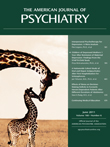Question Regarding Ziprasidone and QTc Interval Prolongation in the ZODIAC Study
To the Editor: In the February 2011 issue of the Journal, Brian L. Strom, M.D., M.P.H., and colleagues (1) discussed ZODIAC data in ways that may be misconstrued. The primary outcome measure was nonsuicidal mortality over the year following initiation of either ziprasidone or olanzapine. The authors found that ziprasidone was no more likely than olanzapine to increase the risk of nonsuicidal mortality when employing “real-world use” of these two agents in patients with schizophrenia. However, no systematic information was sought about baseline or serial electrocardiographic QTc interval measurements or cardiac arrhythmias such as polymorphic ventricular tachycardia or one of its subtypes, torsade de pointes. Among the 18,154 study subjects, there were no cases of torsade de pointes or other ventricular arrhythmias. Despite these limitations, the authors may have inferred conclusions about ziprasidone and QTc interval prolongation that are not supported by the data.
Shortly before Pfizer sought approval from the U.S. Food and Drug Administration for ziprasidone, several drugs had been withdrawn because of QTc interval prolongation, torsade de pointes, and cardiac morbidity and mortality. Pfizer was directed to conduct the Pfizer 054 study (2). Of the next-generation antipsychotic drugs, ziprasidone was most likely (mean=20.3 msec) and olanzapine least likely (mean=6.8 msec) to lengthen the QTc interval. Metabolic inhibitors did not lead to further QTc interval prolongation for either drug in contrast to quetiapine, in which a metabolic inhibitor led to a mean QTc interval prolongation of 19.7 msec. Generally, drug-induced QTc interval lengthening of less than 25 msec is not clinically significant (3).
Given the rarity of antipsychotic drug-associated polymorphic ventricular tachycardia, case reports rather than studies such as ZODIAC will give us the most information about this adverse event. Papers analyzing case reports (4, 5) emphasize that nondrug risk factors for QTc interval prolongation are invariably present in reports of next-generation antipsychotic drug-associated QTc interval prolongation, polymorphic ventricular tachycardia, torsade de pointes, and cardiac death. Such risk factors include hypokalemia, hypomagnesemia, hypocalcemia, bradycardia, preexisting cardiovascular disease, congenital QTc interval prolongation, female sex, advancing age, baseline QTc interval prolongation, and coadministration of nonpsychotropic drugs associated with QTc interval prolongation. Studies attempting to identify next-generation antipsychotic drugs as a cause of QTc interval prolongation must have sufficiently complete data to identify the risk factors listed above. Perhaps Strom et al. (1) might review the case reports of ziprasidone-associated QTc interval prolongation and cardiac arrhythmias on file at Pfizer with this strategy in mind.
1. : Comparative mortality associated with ziprasidone and olanzapine in real-world use among 18,154 patients with schizophrenia: the Ziprasidone Observational Study of Cardiac Outcomes (ZODIAC). Am J Psychiatry 2011; 168:193–201Link, Google Scholar
2.
3. : Acquired Long QT Syndrome. London, Blackwell Futura, 2004Crossref, Google Scholar
4. : New generation antipsychotic drugs and QTc interval prolongation. Prim Care Companion J Clin Psychiatry 2003; 5:205–215Crossref, Medline, Google Scholar
5. : Proarrhythmic risk with antipsychotic and antidepressant drugs: implications in the elderly. Drugs Aging 2009; 26:997–1012Crossref, Medline, Google Scholar



